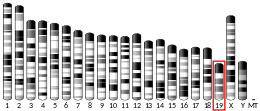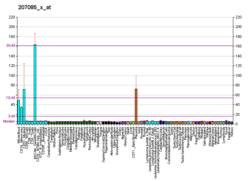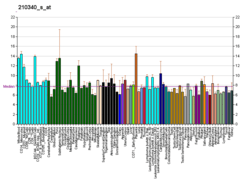Granulocyte-macrophage colony-stimulating factor receptor
The granulocyte-macrophage colony-stimulating factor receptor also known as CD116 (Cluster of Differentiation 116), is a receptor for granulocyte-macrophage colony-stimulating factor, which stimulates the production of white blood cells. The receptor is normally located on myeloblast, mature neutrophil, but not on any erythroid or megakaryocytic lineage cells.[5]
It is associated with Surfactant metabolism dysfunction type 4.
Structure
The granulocyte-macrophage colony-stimulating factor receptor is a heterodimer composed of at least two different subunits; an α chain, and a β chain which is also present in the receptors for IL-3 and IL-5. The α subunit contains a binding site for granulocyte macrophage colony-stimulating factor.[6] The β chain is involved in signal transduction. Association of the α and β subunits results in receptor activation.[7]
Signal transduction
Upon dimerisation of the α and β subunits the β subunit becomes phosphorylated on tyrosine residues by members of the Janus kinase (JAK) family.[7] This leads to association with a Shc adaptor protein. Then Shc interacts with GRB2/SoS complex which results in activation of more downstream molecules in the pathway.[8]
References
- GRCh38: Ensembl release 89: ENSG00000198223 - Ensembl, May 2017
- GRCm38: Ensembl release 89: ENSMUSG00000059326 - Ensembl, May 2017
- "Human PubMed Reference:". National Center for Biotechnology Information, U.S. National Library of Medicine.
- "Mouse PubMed Reference:". National Center for Biotechnology Information, U.S. National Library of Medicine.
- Nicola NA, Metcalf D (Aug 1985). "Binding of 125I-labeled granulocyte colony-stimulating factor to normal murine hemopoietic cells". Journal of Cellular Physiology. 124 (2): 313–21. doi:10.1002/jcp.1041240222. PMID 3876343.
- McClure BJ, Hercus TR, Cambareri BA, Woodcock JM, Bagley CJ, Howlett GJ, Lopez AF (Feb 2003). "Molecular assembly of the ternary granulocyte-macrophage colony-stimulating factor receptor complex". Blood. 101 (4): 1308–15. doi:10.1182/blood-2002-06-1903. PMID 12393492.
- Geijsen N, Koenderman L, Coffer PJ (Mar 2001). "Specificity in cytokine signal transduction: lessons learned from the IL-3/IL-5/GM-CSF receptor family". Cytokine & Growth Factor Reviews. 12 (1): 19–25. doi:10.1016/S1359-6101(00)00019-8. PMID 11312115.
- Doyle SE, Gasson JC (Aug 1998). "Characterization of the role of the human granulocyte-macrophage colony-stimulating factor receptor alpha subunit in the activation of JAK2 and STAT5" (– Scholar search). Blood. 92 (3): 867–76. doi:10.1182/blood.V92.3.867. PMID 9680354.
Further reading
- Rappold G, Willson TA, Henke A, Gough NM (Oct 1992). "Arrangement and localization of the human GM-CSF receptor alpha chain gene CSF2RA within the X-Y pseudoautosomal region". Genomics. 14 (2): 455–61. doi:10.1016/S0888-7543(05)80241-1. PMID 1358805.
- Hayashida K, Kitamura T, Gorman DM, Arai K, Yokota T, Miyajima A (Dec 1990). "Molecular cloning of a second subunit of the receptor for human granulocyte-macrophage colony-stimulating factor (GM-CSF): reconstitution of a high-affinity GM-CSF receptor". Proceedings of the National Academy of Sciences of the United States of America. 87 (24): 9655–9. Bibcode:1990PNAS...87.9655H. doi:10.1073/pnas.87.24.9655. PMC 55231. PMID 1702217.
- Crosier KE, Wong GG, Mathey-Prevot B, Nathan DG, Sieff CA (Sep 1991). "A functional isoform of the human granulocyte/macrophage colony-stimulating factor receptor has an unusual cytoplasmic domain". Proceedings of the National Academy of Sciences of the United States of America. 88 (17): 7744–8. Bibcode:1991PNAS...88.7744C. doi:10.1073/pnas.88.17.7744. PMC 52379. PMID 1715577.
- Raines MA, Liu L, Quan SG, Joe V, DiPersio JF, Golde DW (Sep 1991). "Identification and molecular cloning of a soluble human granulocyte-macrophage colony-stimulating factor receptor". Proceedings of the National Academy of Sciences of the United States of America. 88 (18): 8203–7. Bibcode:1991PNAS...88.8203R. doi:10.1073/pnas.88.18.8203. PMC 52475. PMID 1832774.
- Gough NM, Gearing DP, Nicola NA, Baker E, Pritchard M, Callen DF, Sutherland GR (Jun 1990). "Localization of the human GM-CSF receptor gene to the X-Y pseudoautosomal region". Nature. 345 (6277): 734–6. Bibcode:1990Natur.345..734G. doi:10.1038/345734a0. PMID 1972780.
- Ashworth A, Kraft A (Dec 1990). "Cloning of a potentially soluble receptor for human GM-CSF". Nucleic Acids Research. 18 (23): 7178. doi:10.1093/nar/18.23.7178. PMC 332824. PMID 2148207.
- Gearing DP, King JA, Gough NM, Nicola NA (Dec 1989). "Expression cloning of a receptor for human granulocyte-macrophage colony-stimulating factor". The EMBO Journal. 8 (12): 3667–76. doi:10.1002/j.1460-2075.1989.tb08541.x. PMC 402049. PMID 2555171.
- DiPersio J, Billing P, Kaufman S, Eghtesady P, Williams RE, Gasson JC (Feb 1988). "Characterization of the human granulocyte-macrophage colony-stimulating factor receptor". The Journal of Biological Chemistry. 263 (4): 1834–41. PMID 2828352.
- Williams WV, VonFeldt JM, Rosenbaum H, Ugen KE, Weiner DB (Oct 1994). "Molecular cloning of a soluble form of the granulocyte-macrophage colony-stimulating factor receptor alpha chain from a myelomonocytic cell line. Expression, biologic activity, and preliminary analysis of transcript distribution". Arthritis and Rheumatism. 37 (10): 1468–78. doi:10.1002/art.1780371010. PMID 7945472.
- Jubinsky PT, Laurie AS, Nathan DG, Yetz-Aldepe J, Sieff CA (Dec 1994). "Expression and function of the human granulocyte-macrophage colony-stimulating factor receptor alpha subunit". Blood. 84 (12): 4174–85. doi:10.1182/blood.V84.12.4174.bloodjournal84124174. PMID 7994031.
- Hu X, Emanuel PD, Zuckerman KS (Sep 1994). "Cloning and sequencing of the cDNAs encoding two alternative splicing-derived variants of the alpha subunit of the granulocyte-macrophage colony-stimulating factor receptor". Biochimica et Biophysica Acta (BBA) - Molecular Cell Research. 1223 (2): 306–8. doi:10.1016/0167-4889(94)90241-0. PMID 8086503.
- Nakagawa Y, Kosugi H, Miyajima A, Arai K, Yokota T (Apr 1994). "Structure of the gene encoding the alpha subunit of the human granulocyte-macrophage colony stimulating factor receptor. Implications for the evolution of the cytokine receptor superfamily". The Journal of Biological Chemistry. 269 (14): 10905–12. PMID 8144676.
- Zhao Y, Rong H, Chegini N (Oct 1995). "Expression and selective cellular localization of granulocyte-macrophage colony-stimulating factor (GM-CSF) and GM-CSF alpha and beta receptor messenger ribonucleic acid and protein in human ovarian tissue". Biology of Reproduction. 53 (4): 923–30. doi:10.1095/biolreprod53.4.923. PMID 8547489.
- Lia F, Rajotte D, Clark SC, Hoang T (Nov 1996). "A dominant negative granulocyte-macrophage colony-stimulating factor receptor alpha chain reveals the multimeric structure of the receptor complex". The Journal of Biological Chemistry. 271 (45): 28287–93. doi:10.1074/jbc.271.45.28287. PMID 8910448.
- Wei S, Liu JH, Epling-Burnette PK, Gamero AM, Ussery D, Pearson EW, Elkabani ME, Diaz JI, Djeu JY (Dec 1996). "Critical role of Lyn kinase in inhibition of neutrophil apoptosis by granulocyte-macrophage colony-stimulating factor". Journal of Immunology. 157 (11): 5155–62. PMID 8943427.
- Soldi R, Primo L, Brizzi MF, Sanavio F, Aglietta M, Polentarutti N, Pegoraro L, Mantovani A, Bussolino F (Feb 1997). "Activation of JAK2 in human vascular endothelial cells by granulocyte-macrophage colony-stimulating factor". Blood. 89 (3): 863–72. doi:10.1182/blood.V89.3.863. PMID 9028317.
- Matsuguchi T, Zhao Y, Lilly MB, Kraft AS (Jul 1997). "The cytoplasmic domain of granulocyte-macrophage colony-stimulating factor (GM-CSF) receptor alpha subunit is essential for both GM-CSF-mediated growth and differentiation". The Journal of Biological Chemistry. 272 (28): 17450–9. doi:10.1074/jbc.272.28.17450. PMID 9211889.
- Rivas CI, Vera JC, Delgado-López F, Heaney ML, Guaiquil VH, Zhang RH, Scher HI, Concha II, Nualart F, Cordon-Cardo C, Golde DW (Feb 1998). "Expression of granulocyte-macrophage colony-stimulating factor receptors in human prostate cancer". Blood. 91 (3): 1037–43. doi:10.1182/blood.V91.3.1037. PMID 9446667.
- Hu X, Zuckerman KS (Jun 1998). "Cloning and sequencing of an alternative splicing-derived cDNA variant of the GM-CSF receptor alpha subunit, which encodes a truncated protein". American Journal of Hematology. 58 (2): 145–7. doi:10.1002/(SICI)1096-8652(199806)58:2<145::AID-AJH11>3.0.CO;2-A. PMID 9625584.
- Taha RA, Leung DY, Ghaffar O, Boguniewicz M, Hamid Q (Aug 1998). "In vivo expression of cytokine receptor mRNA in atopic dermatitis". The Journal of Allergy and Clinical Immunology. 102 (2): 245–50. doi:10.1016/S0091-6749(98)70093-4. PMID 9723668.
External links
- GM-CSF+Receptor at the US National Library of Medicine Medical Subject Headings (MeSH)






